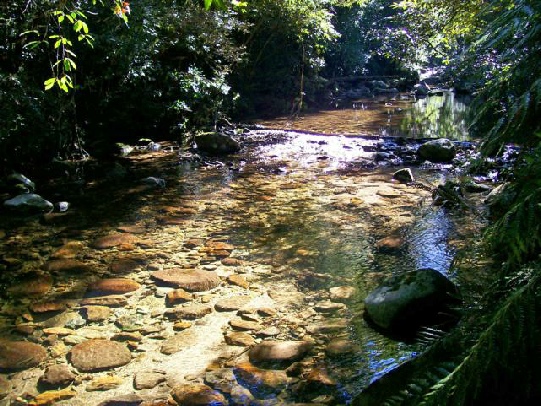

Washpool National Park

Washpool National Park
Less than an hour’s drive from Grafton and Glen Innes, Washpool National Park provides the ideal base for your rainforest adventure. Washpool National Park sits about halfway between Glen Innes and Grafton, straddling the dramatic environs of the Great Dividing Range.
It shares an impressive network of walking tracks with the neighbouring Gibraltar
Ranges National Park, offering some of the state’s most spectacular wilderness walking
opportunities, from short rainforest ambles like the Coombadjha Nature stroll to
the extraordinary Gibraltar-
Pretty camping and picnic spots at Bellbird and Coombadjha camprounds give you a chance to settle in for a couple of hours or days and soak up the ambience of this natural wonder.
Take time out to explore the unparalleled landscapes of Washpool National Park, a
place of steep gorges, clear waters and magnificent tracts of ancient rainforest.
You’ll find some of the most varied and least-
Washpool is part of the Gondwana Rainforests of Australia World Heritage Area, and
offers wonderful wilderness walks lasting half an hour to several days, along with
simple, miles-
It’s also a natural haven for an incredible diversity of plants, mammals, amphibians,
reptiles and birds, including some of Australia’s rarest and most unusual creatures,
like the pouched frog, the long-
Birdwatchers will be in their element here – more than 140 species have been recorded, including the rufous scrub bird and the increasingly rare powerful owl.
Washpool National Park is a special place, here are just some of the reasons why:
Cultural connections
The Bundjalung, Ngarrabul and Gumbaingirri people have a long connection with the lands here; the area was once used as a route between the coast and the tablelands, and as a place to gather a range of resources, such as rainforest fruits.
Walker’s wonderland
Lush rainforest, tinkling streams, dramatic gorges and an impressive plateau environment
at just over the edge of the Great Escarpment make Washpool a singularly spectacular
walking destination. Stretch your legs on an expansive network of graded walking
tracks, including the popular World Heritage walk (which links Gibraltar Range and
Washpool National Parks) and part of the Bicentennial National trail. Nature strolls
and the half-
Rare residents
A huge range of threatened and endangered species enjoy the sanctuary of Washpool’s
diverse habitats. It’s a refuge for mammals including koalas, spotted-
An important legacy
Washpool National Park is part of the Gondwana Rainforests of Australia World Heritage Area, which includes forty parks and reserves stretching along the Great Escarpment from Barrington Tops in NSW to south east Queensland. The area has a long history of selective logging, dating back to the 1800s when the valuable red cedar trees drew timber cutters with bullocks, axes and crosscut saws. With the development of machinery, the increasing pressure to exploit these forests met strong protest action from conservation groups. Ultimately, the park was created in 1983 after a study found the area contained significant plant and animal populations that either weren't found anywhere else in the state or were not well protected in reserves.
Take time out to explore the unparalleled landscapes of Washpool National Park, a
place of steep gorges, clear waters and magnificent tracts of ancient rainforest.
You’ll find some of the most varied and least-
Washpool is part of the Gondwana Rainforests of Australia World Heritage Area, and
offers wonderful wilderness walks lasting half an hour to several days, along with
simple, miles-
It’s also a natural haven for an incredible diversity of plants, mammals, amphibians,
reptiles and birds, including some of Australia’s rarest and most unusual creatures,
like the pouched frog, the long-
Birdwatchers will be in their element here – more than 140 species have been recorded, including the rufous scrub bird and the increasingly rare powerful owl.
Mammals
The forests support many small mammals, especially where old or dead trees provide hollows for nests and shelter. In the last 200 years many animals have lost their habitat due to clearing. Unless we can reverse this habitat loss on private lands, these animals will have to depend on national parks for their long term survival.
Local threatened animals include:
* koala
* spotted-
* parma wallaby
* rufous bettong
* long-
* common dunnart (a mouse-
The endangered Hastings River mouse (Pseudomys oralis) is known to inhabit open eucalypt
forest in Washpool National Park. This species has recently been re-
Birds
Washpool and the adjacent Gibraltar Range National Park are rich in bird life, with
more than 140 species. Rare species like the rufous-
The powerful owl (Ninox strenua), a high order predator found in the Washpool area,
is considered at possible risk of extinction. Each owl requires a large territory
and the extensive areas of tall open forest in the park, with their abundance of
hollow-
Amphibians and reptiles
The park's lizards, snakes and frogs are restricted to particular habitats and are rarely seen.
The forests and swamps in the park have many frog species, including the unusual
pouched frog, a curious rainforest-
Philoria sp. nov. B, the locally endemic species of sphagnum frog is currently being formally described and named. It has been recorded from Gibraltar Range National Park and is found in rainforests and wet open forest near streams and seepage lines.
Invertebrates
A recent report has been prepared for the invertebrate fauna of the Central Eastern Rainforest Reserves of Australia. Endemic species of velvet worm and spiny cray have been described from the park.
© State of New South Wales through the Office of Environment and Heritage
Click on the link for more information about Washpool National Park
Coombadjha Creek
Click the links to see Photos from Washpool National Park, including Boundary Creek Falls and Duffer Creek Falls, the Washpool Walk (Red Cedars Walk), The Haystack, Coombadjha Creek, Washpool World Heritage Rainforest, Raspberry Lookout